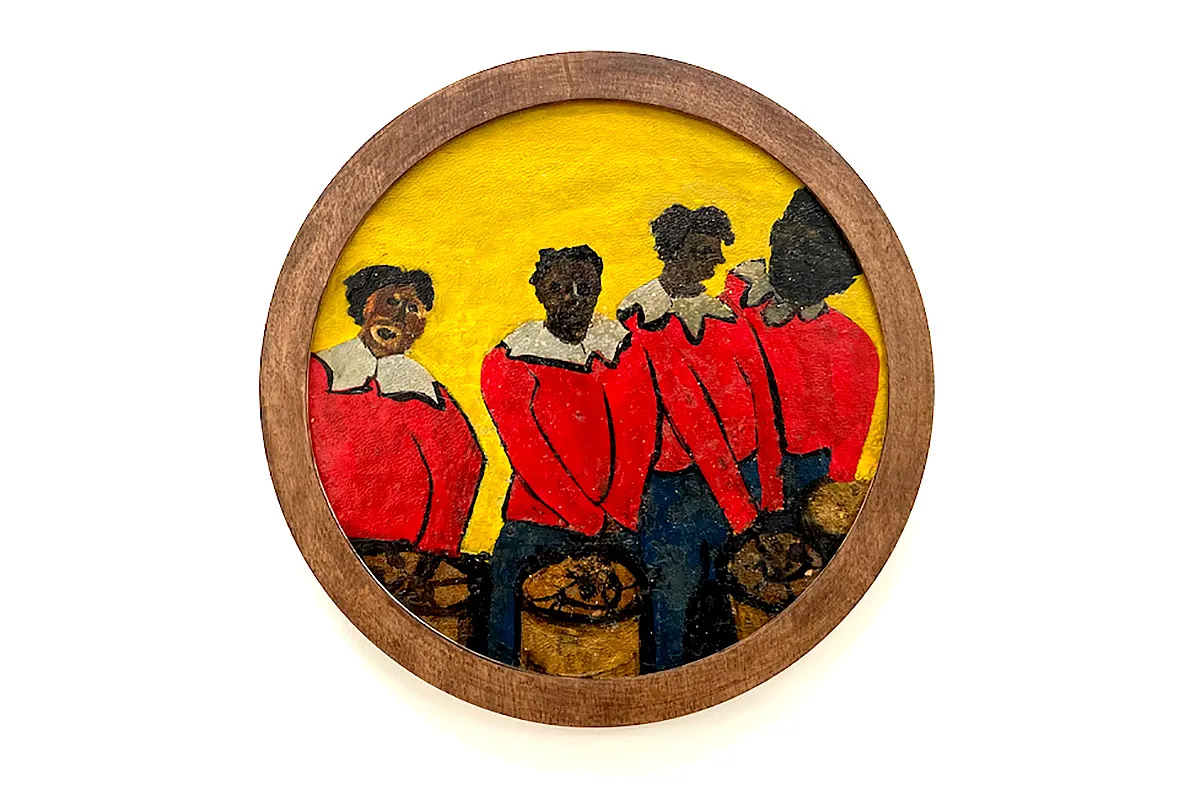The Guardian
Edinburgh Art Festival 2021


The late Barbadian poet Kamau Brathwaite’s voice echoes through a 17th-century stone dovecote at the Jupiter Artland sculpture park. Sounding melodic but pained, we hear his reading of The 21 Days, a poem about the death of his stepson: “on the third day / of yr death. the water in my urine turn to blood / i cover the waterfront of the mirror w/a blue cloth where yr face stood.”
Potted plants fill the floor, bells and shells rest in groves, bandanas hang from a wicker chair. It’s a thoughtful shrine to a Caribbean giant, but equally a crucial locus to reach those elders who have died but remain needed.The installation by Alberta Whittle accompanies her film RESET in the Ballroom Gallery. At 36 minutes long, it begins with meditation – the artist wanting to manifest a moment of calm in the space. The film weaves together clips, filmed on-site, of a dancer rippling through the grounds, footage of Black Lives Matter demonstrations, stills of family portraits, and landscape shots captured between Scotland and Barbados as well as a rendering of a person on a ventilator. Together, they create a cinematic tapestry of our current world. The words “I long for your touch” appear scratched into painted window panels. Whittle is thinking about loss, in all of its bodily manifestations and urges. In both works, she’s providing a sense of comfort, a cool whisper into your ear while the world is on fire.
There are 35 commissions available online and offline for this year’s Edinburgh art festival and many of the works can be linked together by deep preoccupation, nature, collaboration and spirituality.
As soon as you enter Zimbabwean-Scottish artist Sekai Machache’s presentation entitled The Divine Sky at the Stills centre for photography, you are bombarded with blue. Automatic drawings on paper, pigment on fabric and swirling lines coloured in indigo provide highly patterned and decorative work that feel almost too delicate to evoke anything other than tenderness. Yet coupled with a film by Machache filled with scenes of wilderness and poetic meditations, as well as photographic portraits of the artist before a candlelit table, a sense of spirituality and healing soon fills the space.
For Christine Borland’s In Relation to Linum at the Royal Botanic Garden Edinburgh, flax creeps through both floors at Inverleith House. Borland had initially planned to sow seeds on site, but because of the pandemic, she collaborated with 34 gardeners who planted them in gardens, allotments and co-opted public spaces instead. In each room, the flax takes on a different form. In one, the flowered plant appears in zigzag shapes, in another, dried flax spills out from various holes in the wall. A further room contains a panorama of the plant’s first 100 days of life, swimming in alcohol-filled glass tubes that increase in size as they wind around the room. It’s a great lesson in patience, but there’s an absence of chemistry. The show starts with a diaristic text, and one line reads: “My eldest daughter works with me to remove the seeds; she wears a shocking pink skirt.” The stories, the process, the histories, the cultural and colonial context behind flax, feel largely absent and without them, the extracted plant feels nothing more than a specimen.
The festival flourishes with a display of work at Ingleby Gallery by Frank Walter, an Antiguan artist born in 1926 whose work remained unknown during his lifetime. Dozens of his “spools” are on display. These circular paintings are like spyholes into island life. Birds soaring through a fuchsia-pink sky, luscious green fields, a banana-coloured crescent moon, a pear before a fire-red backdrop. But there’s a sadness that glazes the works; even the brightest of pigments seem overcast with a stormy grey. Perhaps it’s Walter’s personal story coming through; he obsessed over his heritage as a descendant of both enslaved people and German slave owners. He travelled to Europe and the UK with high educational hopes but ended up working as a miner and experienced much racism. He also struggled with hallucinations, and spent his final years in isolation after returning to the Caribbean. When you consider his past, these paintings, which at first glance appear to be calm ruminations, suddenly grow sensitive, as though looking at the artist’s wounds.
Isaac Julien’s ambitious 10-screen installation Lessons of the Hour at National Galleries Scotland explores the life and triumphs of American abolitionist, freed slave, and the most photographed man of the 19th century, Frederick Douglass. It’s truly immersive, rich in tonality and its empowering messaging remains relevant today. Douglass spent time in Edinburgh, and scenes of him walking through Scottish landscapes are spliced together with scenes of him delivering his famous speeches as well as FBI footage from the 2015 riots in Baltimore (where Douglass lived as a child) after the death of Freddie Gray, a black man who died in police custody. “The immediate future looks dark and troubled,” Douglass said in the 1894 speech that the work is named after. Perhaps Julien isn’t just remembering Douglass, he’s resurrecting him.